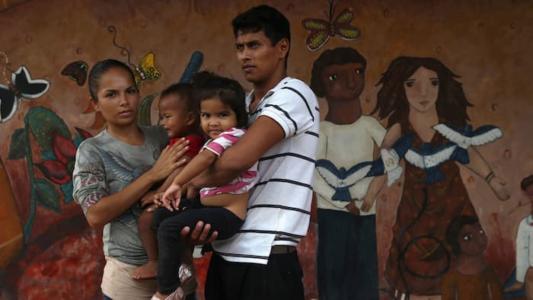Donald Trump wants a wall on America’s southern border to keep illegal immigrants out. But for people such as Rosa, whose husband, mother, sister, brother-in-law and two nephews were murdered in her native Honduras by gangs who then tried to recruit her 14-year-old son, Mexico already acts as a formidable barrier.
Rosa, who asked for her full name not to be used, fled with her two teenage sons only to find herself trapped in a political controversy that the US Republican candidate has put at the heart of his campaign.
Zero net immigration of Mexicans into the US and an 82 per cent fall in people caught trying to cross the US-Mexico border in the past 10 years means that most would-be immigrants detained there are Central Americans. Even without Mr Trump’s fortress frontier, Mexico finds itself under increasing pressure to stem the migrant tide near its source — its own southern border.
“Mexico has become a wall for migrants,” said Sister Magdalena Silva, co-ordinator of Cafemin, a privately run shelter in Mexico City that takes in refugee families, including Rosa’s. “The current policy is to arrest migrants to stop them from getting to the US border.”
The UN estimates 400,000 Central Americans cross illegally into Mexico each year and as many as half of those are fleeing violence. The majority are quickly deported back to dangerous homes.
Unlike in the US, Mexico has broadened asylum laws to recognise that fleeing violence of the kind practised by the street gangs of Honduras and El Salvador can classify someone as a refugee. But the odds are still stacked against asylum seekers: Mexico deported a record 175,000 Central Americans last year, up 68 per cent from the previous year and nearly two-and-a-half times the number deported by the US.
The US is coy about its role in Mexico’s crackdown but is sending $75m in equipment and training to help stop Central Americans from crossing illegally into Mexico. Hosting Mr Trump two weeks ago, President Enrique Peña Nieto said that “making Mexico’s border with our friends and neighbours in Central America more secure is of vital importance for Mexico and the US”.
Rosa left Tegucigalpa, the Honduran capital, with her two teenage sons in January 2016 after a gang tried to recruit one of them on his way home from school. “We know when a gang targets someone, they don’t leave them alone and they follow through on their threats,” she said.

The family asked for help on arrival in Mexico and was channelled into official asylum procedures. That is where things started to sour.
First Rosa and her sons were shipped to a detention centre on the outskirts of Mexico City. There they were assigned different cellblocks and limited to three half-hour visits per week for three months.
After months in detention, Rosa and her sons were denied asylum. No official reason was given and Mexico’s refugee authorities did not respond to interview requests.

Trade and trafficking on the US-Mexico border
“It was like getting a bucket of cold water thrown on me. I told them: ‘Please, please, we can’t go back’,” she says. She appealed, but held out little hope.
Eventually, the family was let out of detention to wait at Cafemin, one of only a handful of places in Mexico caring specifically for the refugee families who keep on coming.
The refugee crisis first hit the headlines in the summer of 2014 when thousands of Central American children arrived alone at the US border. Those numbers have dropped but the US Customs and Border Protection still notes that, overall, arrests in the fiscal year to date — since October 1 — remain “somewhat higher” than in the previous fiscal year.

“By the end of the year we estimate we could have as many as 8,100 individuals seeking asylum in Mexico,” almost all from Central America, says José Sieber, the head of protection in Mexico for the UN High Commissioner for Refugees. That is more than double last year’s number.
Despite the rising number of deportations from Mexico, so far this year, 62 per cent of applications have been accepted compared with 45 per cent in 2015.
Although Mexico grants asylum to more Central Americans than does the US, Sister Magdalena estimates about seven out of 10 people who stay in her shelter still end up heading north.
Rosa and her sons just joined that count: after weeks in limbo waiting on the appeal, they finally threw in the towel after the youths witnessed a woman lying in a pool of blood just blocks away from the shelter.
“I don’t want them growing up thinking this is normal and happens everywhere,” says Rosa. The family travelled to the US, turning themselves in at the US border to ask for asylum. After a few weeks in detention, Rosa and her 14-year-old son were released to live with a family in Baltimore pending a decision. As an adult, her 19-year-old son is still in detention and could get deported.
“We didn’t ever want to leave,” says Rosa. “My sons and I want to be in our country. But we just can’t.”
Source: Financial Times

